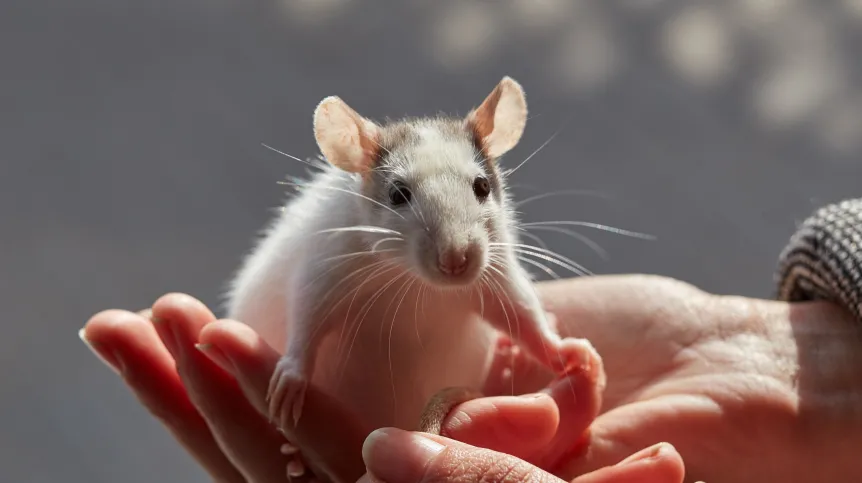
Information about danger can be transmitted across species, possibly through scent, Polish scientists have discovered. Their experiment shows that rats sense the fear of people who handle them, even though the people do not show it.
The scientists from the Laboratory of Emotion Neurobiology and the Laboratory of Brain Imaging at the Nencki Institute of Experimental Biology of the Polish Academy of Sciences, led by Professor Ewelina Knapska suspect that the rats most likely pick up on a scent rather than reactions, as previously believed.
Their experiment showed that rats playing with a person sensed that the person had previously experienced negative emotions, even though the human did not show it. The rats themselves also began to be afraid, and it was visible in their brain activity, the scientist reported on their latest research in the journal Proceedings of the National Academy of Sciences (PNAS).
Not only humans, but many animals, even aquarium fish, are capable of empathy - reading the emotions of others and understanding what they are feeling at a given moment. However, until now, the dominant view among scientists was that these were automatic reactions based on imitation - if one individual froze motionless, the other one would too.
Professor Knapska's team decided to check whether rats, like some domesticated animals, including dogs, goats and horses, would also react to human emotions, especially negative ones, such as fear. Scientists wanted to see what was happening in the animal's brain, because the species studied so far did not offer such opportunities.
The volunteers recruited for the experiment were first conditioned to experience negative emotions. 'During the study, the volunteers sat in front of a computer and learned that the display of squares of a specific colour was accompanied by a mildly unpleasant electrical stimulus,’ the Nencki Institute of Experimental Biology reports in a press release. Some of the participants undergoing this conditioning were observed by their peers while, at the same time, researchers from the Laboratory of Brain Imaging at the Nencki Institute, led by Professor Artur Marchewka recorded the brain activity of the observers. 'It turned out that watching another person's discomfort activated the amygdala in the observer's brain. The amygdala is a very ancient part of the brain responsible for experiencing fear,’ the researchers say.
Dr. Anna Kaźmierowska, who conducted the study, explains that 'the final experiment involved volunteers - authorized to work with laboratory animals - coming to the laboratory daily for several days to acclimatize the rats to them. This is a standard procedure where animals are picked up and petted. Rats learn who is touching them and that it is safe,’ she says.
A control test was conducted after a few days. Volunteers underwent a procedure similar to the final one, but instead of an electric shock, they felt mild vibrations on their forearms. Nothing unpleasant happened to them, and right after that, they went to play with the rats.
'On the last day, however, the volunteers experienced the fear conditioning, during which they were treated with an electric shock. It was unpleasant, which we confirmed by measuring the electrical conductivity of their skin - a nervous or generally emotionally negative person sweats,’ says Professor Knapska.
Then, the volunteers went to a room with a cage containing the rats, placed their hands on it, and played with the animals.
'In the controlled condition - without the electric shock - the rats spent most of their time near the hands of the volunteers, sniffed them, and climbed on them. However, on the last day when the same people came after the fear conditioning, the rats avoided contact with them,’ says Professor Knapska. She adds that rats ran around the cage and sniffed it. 'This is characteristic behaviour for rats when they don't feel secure in their environment; they explore it to find the source of danger,’ she adds.
The disorientation of rats was even more evident when volunteers picked them up. 'They weren't as eager to sniff around; instead, they tucked their heads under the volunteer's shoulder, a sign that they were a little afraid. We saw a change in behaviour between the day when the volunteers experienced vibrations and the situation when they were shocked and became nervous,’ says Dr. Kaźmierowska.
The most interesting results, however, came from the study of the activity of different parts of the rat's brain in the control and experimental situations. In the latter, the amygdala was activated in exactly the same areas where it had been previously recorded in humans who watched their colleagues' discomfort.
Despite the fact that animals did not witness the procedures that humans underwent, they still sensed their fear. The humans did not show any signs of experiencing something unpleasant. The scientists believe that the carrier of information about a potential threat was probably scent. ’Perhaps we emit substances that are universal across different species. They may be found in sweat,’ says Professor Knapska.
According to the Nencki Institute press release, the results of the experiments conducted by her team have fundamental significance for the theory of the origin of empathy.
'The prevailing view in science is that empathic behaviours, especially the ability to respond to the emotions of another individual, evolved from caring for offspring. A mother who can better read a child's emotions and respond to them can take better care of the child, and that offspring has a better chance of survival,’ says Professor Knapska. She adds that the results of the research, and research of other teams, confirm that 'the ability to read the emotions of others may be an adaptation that evolved because it allowed individuals to avoid danger.’
The studies show that 'sensing fear in other species may use the same biological mechanisms as sensing fear in one's own species'.
PAP - Science in Poland
amk/ agt/ kap/
tr. RL













